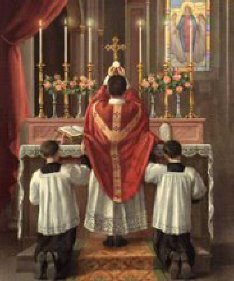His article is well worth reading.
It appears that the future of the normative liturgy of Roman Catholicism is still in doubt, with an ongoing debate over which liturgy will emerge on the horizon, a hybrid liturgy between the Traditional Latin Mass and the Novus Ordo liturgy or a resurgence of the Traditional Latin Mass which will replace the Novus Ordo over the next several generations.
Here are a few excerpts worth considering.
A Passing Phase?
It is right that the controversy over the celebrant, Cardinal Castrillion-Hoyos vs. Bishop Slattery, did not "upstage" what was happening at this Mass.
For, in addition to the sacred mystery of the Mass itself (which was the most important thing of all, of course), something else of considerable importance was occurring on April 24 in Washington - of importance for the future of the Church, and so also of importance for the future of the West.
That "something" is this: the interest in this Mass - which was televised nationwide by EWTN - reveals that, in the West, in the United States, and precisely in Washington, DC, the capital of the US, despite a generation or more of "post-Christian" cultural pressure, there remains a desire, a hunger, to be connected with the Christian past, and to hand on to posterity what was handed down over the centuries, often in the face of much suffering.
In short, the celebration of this Mass, after 40 years and in the midst of an admittedly profound crisis in the Church, suggests that American Catholics, like their counterparts in Europe and around the world, may yet turn to the riches and treasures of their tradition to find a way forward.
And this will not be pure archaism.
It will not reflect a flight from present reality.
Nor will it be a rejection tout court of everything that came with the Second Vatican Council.
Rather, it will be an attempt to pick up the threads of our past and see if they may still be woven into the fabric of our present, in order to create the tapestry of our future.
It is our future that it looks toward - not just our past.
Having just been in Rome, having been present at the papal liturgies during Holy Week, having talked recently with a number of Vatican officials about liturgical matters and about the Second Vatican Council and its legacy, for me this liturgy reflected what Pope Benedict XVI is trying ceaselessly to teach: that the Catholic tradition has not been lost, that it remains to be discovered and lived.
How this will all work out, or course, is yet to be seen.
At least one Vatican official I talked to recently told me he believes the future of the Church's liturgical life will be a type of fusion between the old Mass and the new Mass of Paul VI.
This is the view of many.
But at least one Vatican official I talked to, also in the past month, told me he believes the future is solely and exclusively in a return to the old rite.
"The old rite is our past, and it will be our future, " he told me. "The new Mass is a passing phase. In 50 years, that will be entirely clear." (emphasis added.)
Dr. Moynihan concludes the article with an astute observation regarding Summorum Pontificum and the Orthodox:
And so the liturgy is of central importance to Benedict, and to the Vatican, today.
Benedict and his inner circle see the liturgy as critical to the future of Roman Catholicism. But not only to Roman Catholicism. There is another reason for Benedict's focus on the liturgy.
The Orthodox Connection
It is well known that the Orthodox, in a profound way, share Benedict's conviction that the liturgy is fundamental for faith, and so also for the practice of the faith.
For example, Eastern Orthodoxy's Patriarch Bartholomew I of Constantinople quoted the phrase "lex orandi, lex credendi" in Latin on the occasion of the visit of Pope Benedict XVI to Istanbul in 2006, drawing from the phrase the lesson that, "in liturgy we are reminded of the need to reach unity in faith as well as in prayer."
I believe that Pope Benedict's approval, a few months after that November 2006 visit, on July 7, 2007, of wider use of the old Latin Mass in the Latin rite, was intended to help prepare the reunion of the two great divided branches of Christianity, Catholicism and Orthodoxy.
The path to this reunion must pass, in some essential way, through the liturgy.
Through a shared liturgy. The liturgies of the two Churches must express the same faith if the Churches are ever to be once again in unity - something Christ willed for his disciples in his prayer on the final night with them before his crucifixion.
Inside the Vatican magazine is an excellent publication, by the way. Please consider subscribing.
For more on Summorum Pontificum and the Orthodox, see this previous post:






